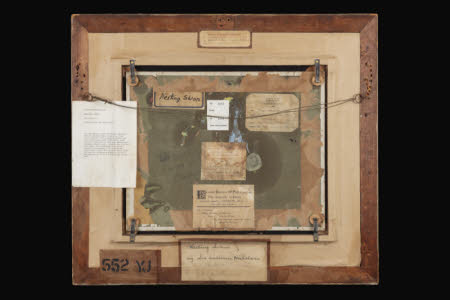Nesting Swans, Chartwell
Sir William Newzam Prior Nicholson (Newark-on-Trent 1872 – Berkshire 1949)
Category
Art / Oil paintings
Date
1934
Materials
Oil on panel
Measurements
560 x 635 mm
Order this imageCollection
Chartwell, Kent
NT 1103204
Summary
Oil on panel, Nesting Swan, Chartwell, by Sir William Newzam Prior Nicholson (Newark-on-Trent 1872 – Berkshire 1949), signed lower left 'Nicholson', 1934. A black swan stands on the bank of the lake at Chartwell, looking towards its nesting mate. The birds have black plumage and red bills. With the lake beyond, trees reflected in the water and other waterfowl. In its original frame.
Full description
The first European record of black swans in their native habitat was made by colonial explorers in the late 17th century, shattering European assumptions that swans could only be white. Black swans were brought to Europe in the 18th century and kept as ornamental waterfowl in private parks. Despite a small feral population, in Britain they remain an ‘introduced’ species and are most commonly seen in captivity. They prefer to nest close to the water’s edge (as seen in Nicholson’s painting), and build their nests with reeds, grasses and other available materials. The female chooses the location of the nest, but both partners partake in its building and share incubation and cygnet-rearing duties. In Nicholson’s painting the relationship between the two partnered birds is conveyed with sensitivity. Various archival documents attest to the interest, care and attention Churchill paid to the swans and other birds living at Chartwell. The original company of black swans were presented to him in 1927 by his close friend Sir Philip Sassoon (1888-39), their population later maintained by the Government of Western Australia. Nicholson produced three oil paintings of the black swans at Chartwell (Reed 2016, cat nos. 719-21). They were almost certainly painted at Chartwell en plein air and are associated with Nicholson’s commission to paint Winston and Clementine Churchill’s silver anniversary portrait in 1933-4. That painting, known only through a preparatory study (NT 1102453), was destroyed by the artist. Nicholson continued to visit Chartwell on several occasions until the outbreak of the Second World War. Two of his three paintings of Chartwell's black swans, Nesting Swans and Black Swans, Chartwell, were exhibited at the National Gallery in London, January 1942. This was the first comprehensive showing of Nicholson's art in London. (Country Life Magazine, 16th January 1942) Churchill received painting lessons from Nicholson, his influence strongly felt in Churchill's own (later) depictions of the black swans which share his tutor’s painterly style and treatment of perspective (NT 1102520, The Studio, Chartwell; Coombs 1967, nos. 379, 384). A paper catalogue of oil paints annotated by Nicholson and sent to Churchill around 1936-7 is retained in the Churchill Archive, in addition to other correspondence between the two men. Churchill thought highly of Nicholson and told Sir John Rothenstein, then Director of the Tate Gallery, that he was 'the person who taught me most about painting'. In turn the artist referred to Churchill as his 'most ardent pupil'. William Nicholson trained at Herkomer's School and the Académie Julian in Paris. He began his career as a designer and maker of posters, prints and book illustration, before turning to painting in around 1900. He married first the Scottish painter Mabel Pryde; their son Ben became a leading figure in British Modernism. Nicholson was independent of any school of painting and refused election to and never exhibited at the Royal Academy. He was knighted in 1936 and in 1942 had an important retrospective at the National Gallery, at which this painting was exhibited (no. 44, as 'Swans').
Provenance
Acquired by Major John ‘Jack’ Spencer-Churchill (1880-1947) before or by 1934 (see label on reverse); by 1941 at 10 Downing Street, London (see label on reverse); by 1949 at Hyde Park Gate, residence of Winston and Clementine Spencer-Churchill (listed in 1949 inventory of Hyde Park Gate, p. 58, as 'Sir W. Nicholson - An oil painting - Nesting Swan, 13 ins. x 16 ins. in a painted frame, glazed.'); the sale of Clementine, Baroness Spencer-Churchill GBE , Christie's, London, 4 March 1977, lot 90 (p. 23, as 'Sir William Nicholson, Nesting Swan, Chartwell, signed, oil canvas-board, 13 x 16in., provenance John Spencer-Churchill [...] painted in 1934'); purchased by Spink & Son on behalf of the present owner; private collection. Purchased by the National Trust for Chartwell in 2024, with the support of a National Trust fund set up by the late Simon Sainsbury.
Marks and inscriptions
Reverse, backing board, centre: Nesting / Swan at / Chartwell Reverse, backing board, bottom right: JS Churchill (double underlined) Reverse, frame, top centre, pasted label: Roland, Browse & Delbanco/ 19 Cork Street Old Bond Street London W1X 2LP 734 7984-5 / 'Exhibited William Nicholson Centenary / Exhibition 1972' (printed and inscribed) Reverse, backing board, top right, pasted label : National Gallery / Trafalgar Square / Exhibitions / 1941 / Owner 'Major John Churchill' / Address '10 Downing Street SW. 1' / Title 'Swans' / Artist 'Sir William Nicholson' / Register Number '1019' (printed and inscribed) Reverse, backing board, centre, pasted label: Exhibition of Works by / 'William Nicholson' / Held at the Leicester Galleries, / Leicester Square, London / 'June' 1934 / No.'81 "Swans"' / Purchaser 'John Spencer Churchill Esq.' (printed and inscribed) Reverse, backing board, bottom centre, pasted label: Ernest Brown & Phillips, Ltd. / The Leicester Galleries, Leicester Square, London, W.C. 2 [etc] (printed) Reverse, frame, bottom centre, pasted label: Nesting Swans / by Sir William Nicholson (inscribed) Reverse, frame, bottom left, pasted label : 552 YJ (stencilled) Reverse, backing board, top left, pasted label : Nesting Swan (inscribed)
Makers and roles
Sir William Newzam Prior Nicholson (Newark-on-Trent 1872 – Berkshire 1949), artist
References
Reed 2011 Patricia Reed, William Nicholson Catalogue Raisonné of the Oil Paintings, Yale Universiy Press, 2011, no. 719, p. 554.

